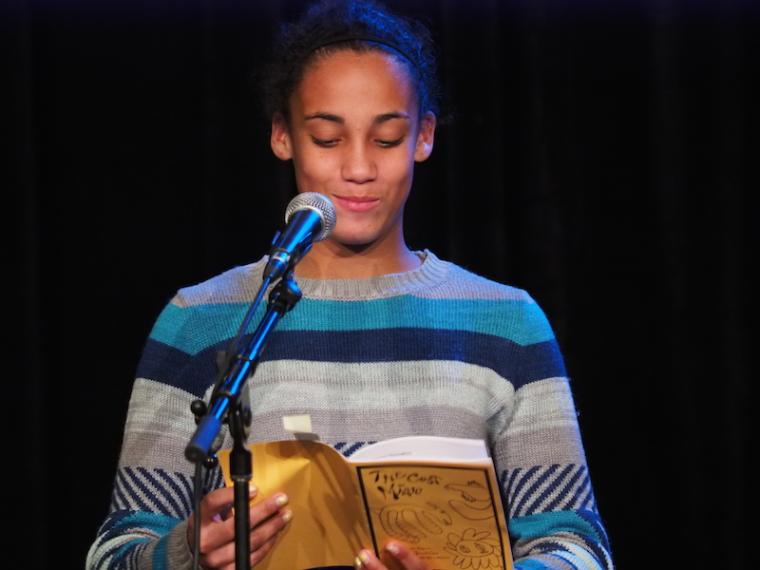An Invitation to Write
December 15, 2016
Amanda Nagy

On the day after election day, senior Rob Jamner awoke at 5 a.m. feeling anxious and unsettled. He sat down at his kitchen table and wrote the following four lines:
Let in as much light as you can take.
Let it fill the places that are missing.
We are always breaking into being.
That same day, Jamner used the poem as an introduction to his writing lesson for eighth-graders in Oberlin’s Langston Middle School.
“I didn’t know how the eighth graders would be feeling that day,” says Jamner, a creative writing major from Louisville, Kentucky, enrolled in Oberlin’s Teaching Imaginative Writing course. “I imagined that they would be feeling a variety of ways, and I wanted to give them the opportunity to express themselves in their writing, whether it had to do with the lesson or not. So I decided to show them my notebook. I told them that I use it for all sorts of things: journal entries, poems, doodles, songs.
“I added, ‘Sometimes I write because there is something that I need to write. This morning I needed to write.’ Then I shared the four lines that I had written in response to the election.”
Jamner continued with his original lesson, which he had previously workshopped and practiced with Director of Oberlin’s Writers-in-the-Schools Program Lynn Powell, using the poem "Stone" by Charles Simic. At the end, when he gave the students a writing prompt modeled after "Stone," he reminded them about the poem he had written earlier in the morning. “I said, ‘If there is anything that you need to write, even if it does not follow the prompt, I encourage you to write it.’”
When Powell’s students are delivering poetry lessons to sixth-, seventh-, and eighth-grade language arts classes at Langston, the preferred terminology is “invitation to write,” because prompt sounds too much like homework.
“It’s an American cultural phenomenon that people generally don’t have much experience with contemporary poetry, and they carry around impressions that poetry is either really sappy or really difficult and obscure,” explains Powell, the award-winning author of two books of poetry and a book of nonfiction, Framing Innocence: A Mother’s Photographs, A Prosecutor’s Zeal, and a Small Town’s Response. “In our work in the schools, we try to break through those misconceptions and cliched notions of poetry. We do that by immersing students in the experience of writing poems, with lessons that stimulate their imagination and give them both freedom and guidance.”
Teaching Imaginative Writing, which Powell instructs every fall in the creative writing program, is the centerpiece of Oberlin WITS (Writers-in the-Schools), a recently expanded program that allows Oberlin students to continue working in the local schools in the spring and receive practicum credit for their additional teaching. This spring will be the third year of the practicum.
In the course, students create and workshop their own lesson plans and participate in seven-day residencies with Powell in Langston’s classrooms. Powell’s class publishes anthologies of the middle schoolers’ writing and holds a celebration and book launch at the Cat in the Cream Coffeehouse, where the young poets recite their work.
The course, which meets each week for three hours in the evening, is based on an apprenticeship model. Starting in the summer, Powell’s students read 200 pages of lesson plans that Powell’s past students have written since the course began in 2010. Once the semester begins, the students engage in The Great Poem Hunt to find other poems with potential to jumpstart good lessons. “Essentially, we’re trying to hit that sweet spot where the poem will matter to the middle school kids, but also be a strong poem on its own terms, full of imagination and insight. We don’t want to condescend to the middle school students, ever,” Powell says. By the third week, college students are ready to start workshopping their own new lessons.
Before teaching at Oberlin, Powell worked for 20 years as a Writer-in-the-Schools for the New Jersey State Council on the Arts and then for the Ohio Arts Council. She worked with students in grades K-12, in urban, suburban, and rural schools, and in residencies that spanned in length from one day to one year.
“The Oberlin students and I go into the school as visiting artists. We’re speaking as writers who practice the art we are inviting the middle schoolers into. I tell my students that good teaching is when you go into the classroom as passionate and prepared as you can be, knowing the poems you are going to teach inside and out, and knowing where you want the lesson to go. And then you put your lesson to the side and have an authentic conversation with the students about the work you’ve brought to share with them.”
In course evaluations, many Oberlin students have said the experience is transformative.
Milena Williamson, a senior majoring in English and creative writing, taught in a sixth-grade residency last fall. She returned to the program this fall as Powell’s teaching assistant, participating in class discussions and providing the other college students with insight about teaching middle schoolers. She also did her own residency in a seventh-grade class, where she designed two new lesson plans.
“I think poetry is an often overlooked art form, and in an age of ever-increasing emphasis on standardized tests, any opportunity for students to write creatively is valuable,” says Williamson, who is from Swarthmore, Pennsylvania.
The class has also changed her perspective on writing. “As a creative writing major who is used to laboring over a single line or word in a poem, it's really refreshing to sit down and write something quickly. I feel like I have rediscovered my natural poetical voice by responding to these ‘invitations to write.’ Even though I still labor over a single line or word in my poetry capstone, I try to bring the spontaneity from this kind of writing into my other poetry.”
Powell says Langston’s teachers have been the program’s biggest supporters. “The teachers always say, ‘I wish you could teach all my classes.’ And we wish we could, too. Our work in the schools influences the teachers. Their attitude and openness to poetry changes. The seventh-grade Language Arts teacher, excited by the poems she was writing during our residencies, recently earned a Master of Fine Arts in poetry from Ashland University.”
But probably the biggest testament to the program’s success is the published anthology and Cat in the Cream reading. On the Monday evening after Thanksgiving, over 40 Langston students voluntarily took to the stage and read their poems in the spotlight for 200 guests.
“They always read with incredible passion,” Powell says. “The parents come up to me afterward and thank me over and over. It opens the eyes of adults. They realize how imaginative and smart and witty these kids are, how they suffer, how they grapple with deep metaphysical questions. And it gives kids amazing confidence to speak so powerfully in their own voices.”
In all her years of doing this work, Powell has never had a student who wasn’t represented in the book. “The dignity of being a published writer, and what that can do for engagement in literacy and reading, is profound.”
Tags:
You may also like…
Oberlin Opera Brings “Jack and the Beanstalk” to Schools Across Northeast Ohio for Winter Term
March 10, 2025
“It was really amazing going into the community and performing an art form that they probably haven't seen before,” second-year voice major Ella Vaugn said, “Teachers would tell us that they've never seen their students so engaged.”
Friday Afternoon with Lab Crawl
October 30, 2023
This year’s Lab Crawl drew what may be the largest crowd in the event’s illustrious history, with some 500 students and dozens of faculty taking part. Missed out on the excitement? It looked something like this.
Lab Crawl: It’s Not Just for Scientists
October 24, 2023
Oct. 27 open house highlights research across the sciences—and just about everywhere else.


